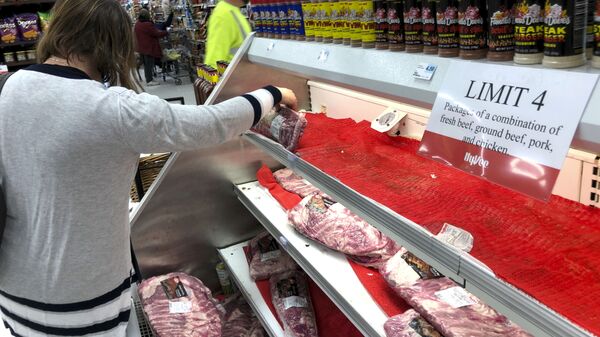Ordinary grocers across US states have raised meat prices substantially and introduced limits on the amounts of beef, pork and chicken products one customer can buy at a time, while premium venders selling meats at double or even triple the price have reported expanding production and demand, Bloomberg has reported, citing fresh industry figures.
Rationing has been introduced at major national chains including Costco and Kroger due to production cuts by giant producers like Tyson Foods and Cargill due to coronavirus-related disruptions, with the United Food and Commercial Workers International Union reporting the closure of at least 30 plants, and coronavirus infection or exposure among over 10,000 workers (i.e. about four in five beef and pork workers and 1/3 of poultry workers), according to the AP.
Livestock market analyst Cassandra Fish told Bloomberg that meat processing in the United States is an extremely consolidated business, with just 50 giant plants making up 98 percent of total processing.
Meanwhile, luxury meat producers selling grass-fed beef, Amish-raised chicken and heritage pork have enjoyed a boom in demand. Bloomberg attributes specialty meat producers’ success to a lack of dependence on economies of scale, including production at massive plants of hundreds of workers processing thousands of animals. Instead, specialty meat producers use small scale production where social distancing is easier to enforce, including a series of family farms and small regional meat processers.
Unfortunately, grass-fed beef is said to contribute only 5 percent of total beef sold in the United States at the moment, while specialty pork and chicken make up just 1 percent of output.
In related news, this week the US Meat Export Federation reported a 40 percent jump in pork exports, a 9 percent growth in beef exports, and an 8 percent increase in chicken exports during the first quarter of 2020. Pork exports also jumped by 40 percent in the final week of April amid surging demand in China, Japan, Mexico and Canada, according to Department of Agriculture figures, while beef exports dropped 22 percent during the same period. Many of these exports grew thanks to long-term contracts signed prior to the coronavirus outbreak, as well as the phase one trade deal signed by the US and China in January which committed Beijing to increase its purchase of US food products.





